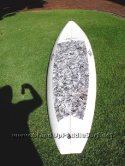Joe Blair 12-6 – Interview
In follow up to my previous post, I was able to hook up with Joe Blair for an interview on his all new 12’6″ race board. He shared his philosophies on why the board works, why it’s so different than others and all in the normal Blair style. Check out the interview and hear more of his thoughts.
Transcript:
Evan Leong: We’re here with Joe Blair, we’re going to talk about the new 12’6” race board that he just shaped up, something that we’ve been talking about for probably 4 months and finally we got it.
(0:00:13.8) Why don’t you explain a little bit of what you’re thinking when you made this board, because it looks way different than any of the other boards that I’ve ridden. The nose is different, the bottom looks different, and the whole thing is different.
Joe Blair: (0:00:28.0)Well one of the things I put into it is, looking at the surfboards all the kids are riding today and they all have full concave bottoms. And then I used to make race boards and slalom race boards and the windsurfing for _______(0:00:40.2) And the concave worked very well, what I wanted to do was make it wider too, because all the boards have such a narrow nose and tail that sinks. You want glide, I’ve wanted to get the width? (0:00:54.6) and the concave in there to make the board glide faster as you paddle it.
(0:00:59.3) And then the entry, that is really a tricky thing as your entry. You want to have a fast entry into your long black spot with the nose kick. And to me that’s a very important thing to have on the board right there.
Evan Leong: (0:01:12.0) You know on this board it almost feels like it’s more of a surfing kind of a board. I get more of a feel like I’m surfing a wave as opposed to kinda riding a longer, (I hate to say the word) ‘kayak’ but that’s kind of me what I feel on really long boards because it’s kind of these narrow and long things. This one almost feels like you’re surfing it for a lot of it. Then I would think, maybe that kinda detracts from the speed but it doesn’t seem to. What’s the scoop on that? (0:01:43.9)
Joe Blair: Well I ran that concave way up to the nose plus made the nose wider. And I put really soft rails on that board all the way through to free it from many of the wave action which it might get, because the ocean has quite a different wave action, wind and chop and all kinds of different action. I wanted to free it up it could keep it going and not stick. I think in reference to the concave and the nose is super important. Otherwise you have a boat hull(0:02:17.7) principle and it plows.
Evan Leong: (0:02:22.1) Why didn’t you go with a displacement hull type thinking, like some of the other ones we’re seeing now?
Joe Blair: (002:28.8) Well when I built the slalom boards I was wondering what the guys who have the concave running up front same with the same wave boards and the speed boards are really interesting that were made back then too. It was speed racing and windsurfing and it had the full concave all the way through going into the a double barrel(0:02:46.7) but I felt the single throughout the whole board is faster than having a double barrel most of them have double barrel. And that’s more of a boat hole thing and that seems to push water in railroad.
(0:02:57.3) And you were talking about the surfy feeling. I was trying to free it up instead of stick. I’ve got softer rails, the concave running all the way through and also having that clean fast entry going through. It’s keep gonna your speed up and not stick. (0:03:12.6) I think the whole keyword will be sticking like a boat hole and plowing. Because water is not always flat. And I’m talking about a race board that might be longer for lakes and where you don’t have much wind, well I think the width in(0:0:30.5)nose and running that concave is gonna be faster maybe you take a bullet you think you get race board that’s really narrow that looks like a bullet, that’s gonna sink on you.
Evan Leong: (0:03:42.2) How is it then that 12’6” board… I mean this is the scenario: I took the thing out I’ve ridden it 3 times and far, pretty much in epic conditions, that gotta be mentioned, I mean it’s really high winds 20 hrs. plus at my back, decent swell-not big but at least knee high almost some coming in a little bit higher than that and my best time ever before on 15’ board was 1:29 from the blinker buoy in Hawaii Kai to Kaimana and then yesterday I did it in a 12’6” in 1:17 minutes which blew my mind. Because I was thinking there’s no way this 12’6” should be as fast as the 15’.
Joe Blair: (0:04:31.9)Well what I did was I try to have more leaders in the 12’6” and even the 14’ that’s why I made them wider in the nose, wider in the middle, wider in the tail, and also at the tail foot too. When you get back there you have more glide. I was putting the gliding area into the width (0:04:51.4) instead of making it narrow it sinks. And that was my idea on that.
Evan Leong: (0:04:56.2) what do you think about for boards now than in lighter wind conditions, smaller chops, if we have the opportunity to just make unlimited, will we still stay in the 14’ or 15’ range or we’re making these 18’ ones or what do you think?
Joe Blair: (0:5:17.3) Well I think we’re we’ll remember the 15’ and we’ve widen the nose, dropped the nose 4 inches from which one I made for you for the ocean with the more __________ (0:05:25.9) conditions. We’re gonna get more glide rather than that narrow nose with the boat hull issues(0:05:31.6) And then widen the tail too throughout the whole board wit(0:05:35.7)I think _______ (0:05:36.0) is gonna give us more glide and running the concave through it. I even tried a bullet board that has a low rocker like that and the glide on it was incredible. I was really extremely impressed. And that was a lit bit a proof to prove my _____(0:05:52.2) too.
Evan Leong: (0:5:55.1)That’s weird, I don’t know, just a lot of them are narrower and long right. Like almost opposite.
Joe Blair: They might be narrower but they’re doing right. (0:5:58.8)
Joe Blair: (0:06:03.4)Yes and maybe sometimes when you look at the opposite of things it’s better. You never can just prove anything until you try it. But to me plainning abilities is very important when you start pulling that nose and tail and you’re sinking, you’re not plainning. The wit I think, on racing lakes because we’re gonna it a major factor but you’re gonna have to have the right entry and the concave is gonna be a major factor in it too.
Evan Leong: (0:06:26.8) And then what about for bigger guys, between 200+ lbs. maybe 230+ lbs. as opposed to 160-170 lbs. guy?
Joe Blair: (0:06:40.8)I think a special board should to be made for bigger guys. They’re gonna have to go wider. They’re gonna be able to do the same glide because of their weight. Things change when you have weight added to it. And it would be fair to stick a heavy guy on the same board, the lighter guys gotta be plainning himself even if the heavy guy wants to enter a race, then he would need to make a board that’s wider and a little thicker, so he has equal _____ (0:07:09.6) area.
(0:07:12.5)See what else I put there; I like the concave deck that I put in there because you’re feet are in an angle. If you used to put your feet together it ______ (0:07:19.6) straight, when you stretch your legs apart, you’re gonna have a bit of 6° or 7°, so I put the concave there you’re pushing against the flat and you’re won’t fatigue ________(0:07:32.7) and you’re gonna have more paddle power because the angle pressure that you put, and that’s what I like in that dome deck on that board. You can last longer.





0 Responses to “Joe Blair 12-6 – Interview”